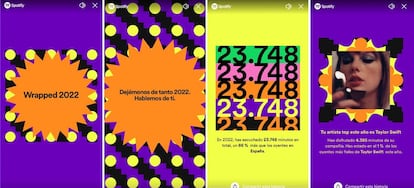Spotify Wrapped, the musical selfie monopolizing the conversation on Twitter
The platform’s campaign packages users’ most listened-to songs of the year, producing yet another chance to talk about ourselves on social media

Maria is making lunch when she receives a message from a friend. Spotify Wrapped has just been released – the platform’s viral marketing campaign that gives each user a personalized summary of the soundtrack to their year. It packages your most listened-to songs, your favorite albums and genres. Maria, a 23-year-old journalist based in Madrid who prefers not to give her last name, has been waiting for this moment all week and is a little nervous. “What if my most listened-to track is the music to [the Colombian soap opera] La reina del flow...,” she says, laughing.
The music starts to play and geometric shapes in fluorescent colors kick off her customized recap. Then a message flashes on the screen of her phone: “Let’s not talk about 2022. Let’s talk about you.” In the background, songs play that Maria feels proud to have listened to – songs by Quevedo, Melendi, Bizarrap, Rigoberta Bandini and Bad Bunny. She takes to social media to share her Spotify Wrapped. She is not the only one.
Bad Bunny was the most listened-to artist on Spotify in 2022, but that probably doesn’t interest anyone but Bad Bunny. The average Spotify user is sharing their musical tastes in a bid to talk about themselves rather than the music. By clicking on the Spotify Wrapped hashtag on Twitter, you won’t find a conversation about musical trends, but rather a set of monologues in which people discuss what their tastes say about them. It is Spotify’s take on the culture of self, which has permeated everything from social networks to cultural consumption. “Posturing has arrived in music,” says Julio Arce, professor of Musicology at the Complutense University of Madrid. “It makes sense, as music serves to reflect who we are.”
Arce quotes the philosopher Zygmunt Bauman to argue that we are in “a confessional society” in which “the boundaries between the private and the public have blurred.” Social networks encourage us to share what we do, to define ourselves, describe ourselves and show off who we are at all times. Arce also quotes the sociologist Mike Featherstone to explain that “we need to individualize ourselves, to be or appear to be unique.” Spotify has been able to take advantage of these two driving forces to create a tool that presents us to our friends as eclectic and original music lovers.
In 2022, Maria has spent more than 50,000 minutes listening to Spotify. She is what is known as “a musical nomad,” but despite her nomadic nature, the app has defined her. As far as Spotify is concerned, it means she moves through many genres, but when she discovers a new one, she stays with it for a while. Other Spotify categories cropping up on social media include “unconditional fan” and “doctor of music.”
“It is often said that music serves to unite, but it is also used to divide us, to hierarchize us and place us on one side or another,” Arce points out. “The music you listen to can say a lot about who you are or want to be; it’s a way of identifying yourself personally and projecting an image.”
The mechanics of Spotify Wrapped – which summarizes your musical habits on different screens like Instagram stories – helps with this projection. It provides enough data – sometimes absurd statistics such as “you are among the 0.05% of Rosalía’s most loyal listeners,” – for the user to find a screen that makes them feel unique. This segmented information enables the listener to publish only what they want to show to the world on social media. As Carl Wilson pointed out in his book Let’s Talk About Love: A Journey To The End of Taste, we lie about what we like in order to be accepted. And then we say that others have bad taste.
That’s why the feature available on Spotify allowing us to see what others are listening to in real time has not been successful while Spotify Wrapped has. It’s the difference between streaming your life live, Big-Brother-style, or sharing some idealized snippets of it, as if you were on Instagram. “You don’t post the first selfie you take either, but the third or fourth – the one that puts you in the best light,” says Juan de Dios, Arce’s musicologist colleague at Complutense. “With Spotify Wrapped, it’s the same thing: it’s not what you listen to, but the image you want to project of what you listen to. There’s a selection process.”
The customized recap allows us to reaffirm ourselves through songs, something that most people start doing at puberty. “Music is the first thing you use to distinguish yourself from your parents, from your elders,” De Dios explains. “It’s fundamental in the process of shaping who we are, a process that goes from childhood through adolescence, when songs and music idols become really important.” When we are sharing our musical tastes on social media, we are explaining who we are to the world, he adds.
Other digital platforms related to cultural consumption, such as Goodreads for books and Filmaffinity for movies, are based on the same premise. But none has been able to take advantage of its potential as well as Spotify. The fact Spotify not only recommends content, but also allows us to consume it, gives it the edge. But it is also the fact that it has been learning what buttons to push to get the user’s interest since 2016.
Journalist Haley Weiss at The Atlantic delved into the Spotify Wrapped phenomenon four years ago. She defined it as “a masterful coup of free advertising and an impressive display of consumer trust at a moment when our faith in tech companies is historically low.” The data proves her right. In 2021, the app went from being ranked 15th in downloads to second in just a few hours, simply by launching the annual compilation. This year, as soon as it was announced the wrap was available, its hashtag was trending on Twitter. Within minutes, Twitter users were posting their results.
It’s all about the data
To set up Spotify Wrapped for each user, the platform needs detailed information about what is listened to throughout the year. It’s a win-win situation for both parties: Spotify gets the data from its customers with little resistance, and the listener gets music, playlists and suggestions tailored to their tastes. The world’s leading streaming music platform – it has 381 million monthly active users worldwide, of which 161 million are paying users – relies on individualization to keep its users and build loyalty. Its system uses computerized recommendation procedures based on users’ tastes. Rose Marie Santini, professor of communication at the University of Rio de Janeiro, has studied the business models that use these recommendation systems and considers that “this is not a recent practice, but is inherent to the capitalist system. It is an attempt to predict, organize and orient consumer demand.”
Spotify’s competitors, the Apple Music and Tidal platforms, have recently copied the formula. Some outside companies have jumped on the Spotify bandwagon, lifting its data. The Instafest app, for example, compiles a user’s most-listened-to artists and mashes them into what looks like a festival poster. The image has flooded social media in recent weeks with people fantasizing about the idea of a bespoke festival, though since the release of Spotify’s annual recap, the noise has decreased. The comedian Carmen Romero summed up the absurdity of the trend in a tweet: “I’m in shock – people love the festival that would be set up with the music they listen to. Would you really go to see your favorite bands? Would you even like it if they all coincided together at a festival? Really? I just don’t believe it.”
Another of the serious advantages of Spotify Wrapped is the launch date. Come December, society, the media and online platforms all encourage us to review the highlights and, of course, our personal soundtrack to the year. “It’s the right climatic moment for a campaign like this to work,” explains Juan de Dios. “You turn over a new leaf, make new resolutions, renew your gym membership – and renew your Spotify subscription.”
Tu suscripción se está usando en otro dispositivo
¿Quieres añadir otro usuario a tu suscripción?
Si continúas leyendo en este dispositivo, no se podrá leer en el otro.
FlechaTu suscripción se está usando en otro dispositivo y solo puedes acceder a EL PAÍS desde un dispositivo a la vez.
Si quieres compartir tu cuenta, cambia tu suscripción a la modalidad Premium, así podrás añadir otro usuario. Cada uno accederá con su propia cuenta de email, lo que os permitirá personalizar vuestra experiencia en EL PAÍS.
¿Tienes una suscripción de empresa? Accede aquí para contratar más cuentas.
En el caso de no saber quién está usando tu cuenta, te recomendamos cambiar tu contraseña aquí.
Si decides continuar compartiendo tu cuenta, este mensaje se mostrará en tu dispositivo y en el de la otra persona que está usando tu cuenta de forma indefinida, afectando a tu experiencia de lectura. Puedes consultar aquí los términos y condiciones de la suscripción digital.
More information
Archived In
Últimas noticias
Venezuela hardens its ‘revolutionary state’ project amid pressure from Trump
Sydney Sweeney, the actress praised by Trump: ‘Women are up against what society wants them to be’
The Bolsonaro surname: An advantage or liability in Brazil’s 2026 presidential elections?
Raúl Rocha, from jet-setting with Miss Universe to arms trafficking and fuel theft
Most viewed
- Reinhard Genzel, Nobel laureate in physics: ‘One-minute videos will never give you the truth’
- Pablo Escobar’s hippos: A serious environmental problem, 40 years on
- Charles Dubouloz, mountaineering star, retires at 36 with a farewell tour inspired by Walter Bonatti
- Why we lost the habit of sleeping in two segments and how that changed our sense of time
- The fall of a prolific science journal exposes the billion-dollar profits of scientific publishing










































